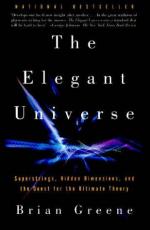
|
| Name: _________________________ | Period: ___________________ |
This quiz consists of 5 multiple choice and 5 short answer questions through Chapter Twelve, Beyond Strings, In Search of M-Theory.
Multiple Choice Questions
1. Why are the extra dimensions needed in string theory?
(a) To remove time from its equations.
(b) To provide more space for strings.
(c) To prevent the negative and infinite answers to its physical equations.
(d) To account for the infinite-energy problem.
2. What is the result when a particle of matter and a particle of antimatter are brought into contact?
(a) Energy is released and both particles are destroyed.
(b) A black hole is formed.
(c) A theoretically unlimited amount of energy is released.
(d) A strange quark is formed.
3. How many dimensions did the tiny objects involved in the original statement of string theory have?
(a) Four.
(b) Two.
(c) One.
(d) Three.
4. Quantum chromodynamics concerns quantum mechanics and ____.
(a) The weak force.
(b) The electromagnetic force.
(c) Gravity.
(d) The strong force.
5. Which of the following is one of the major problems in using both quantum physics and general relativity?
(a) General relativity is time-dependant, quantum physics is a steady-state theory.
(b) General relativity is a wave theory, but quantum physics is a particle theory.
(c) Quantum physics predicts that all particles are massless.
(d) At small scales, quantum physics predicts uncertainty, but general relativity requires certainty.
Short Answer Questions
1. Which of the following best describes a wormhole?
2. Who provided the computer programming to process the results of the Morrison-Greene experiment?
3. The first version of string theory did not include any particles of _____.
4. Which one of the following do physicists believe occurs at the central point of a black hole?
5. By what factor is the minimum mass of a wrapped string in determined?
|
This section contains 321 words (approx. 2 pages at 300 words per page) |

|




